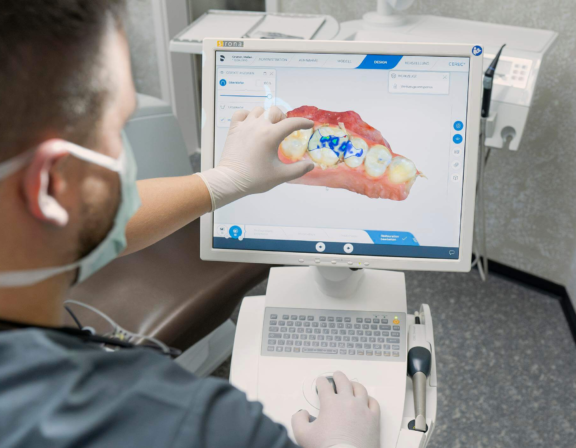CEREC 3D

Modern new technologies have also changed the methods of dental treatment. We are all aware that in order to have healthy teeth, you need to carefully monitor their condition and visit a dentist every six months. You can visit our office without fear of pain – we use modern equipment and advanced materials. The entire treatment process can be monitored on the screen – all procedures are shot by an intraoral camera. Images are taken by an X-ray machine the radiation of which is reduced to a minimum. Most of the filling materials serve only 2-5 years. By replacing a filling with the new one, tooth defects every time increase. Adjacent teeth which come into contact with the filled teeth, and chewing surface of the tooth are damaged most often. Why? Usually, due to poor polishing results. If jagged and uneven edges of filling remain, there food accumulates and that causes the development of caries, gum inflammation and subsequent complications. All fillings shrink when they harden and create micro cracks for moisture which leads to changes in colour of fillings, and finally they become loose and fall out. After tome time, dental pulp has to be removed and the tooth needs a prosthetic crown. Currently, the best and least harmful to the tooth restoration and replacement material is porcelain. Porcelain does not shrink, do not accumulate moisture, does not change colour, its properties are very close to the natural tooth enamel. Porcelain is non-toxic, and it does not cause allergic reactions. This is the latest and high-precision material used in the restoration of partial tooth defects.
What are the differences between the prostheses restoring the tooth? The inlay is used for the reconstruction of defects in the fissures or outer side when none of the cusps of the tooth is damaged. When one or more teeth cusps are missing but at least one cusp remains, an onlay is produced. When a tooth is restored by an onlay, much of tooth tissue is preserved, as there is no need to grind the whole tooth. If the tooth is damaged more, a crown is made and the anatomical shape of the tooth is restored which, over the time, remains unchanged. Masticatory function is fully restored.
The tooth can be restored by porcelain inlay (onlay) or crown in two ways: by indirect (laboratory) and direct way. By restoring the tooth in the laboratory, the dentist prepares the tooth prosthesis, takes the impression and passes it to the laboratory of dental technicians. While the prosthesis is being made, a temporary filling is placed on the tooth. A technician produces a model, and later the inlay according to the impression. Usually it takes 2-3 days or longer. During a visit, the dentist applies the inlay in the mouth and cements it.
When restoring a tooth directly, all the procedures are performed using the CEREC machine during one visit when the patient is able to observe the process. Neither temporary fillings nor crowns are required, and there is no risk that it will fall out and cause complications. Time has shown that such prostheses serve perfect and are irreplaceable at abnormal tooth wear, when the occlusion must be moved up.
Patients want to have a beautiful smile; therefore, currently veneers are especially popular. Veneers are porcelain dentures placed only on the front tooth. Often, this is a great alternative to orthodontic treatment. If there are large gaps between the front teeth or several teeth are uneven, the patient may feel uncomfortable, especially if the person has to communicate with other people and smile broadly, or work on the stage. The person has to endure a long orthodontic treatment for several years, to wear braces. Not everyone has a bit of patience. Patients are often dissatisfied with shape, colour, and fillings of their tooth. All this can be adjusted and you can enjoy a dream smile. The procedure is simple: a dentist polishes a narrow layer of the outer tooth enamel, an optical dental impression is made, which can be see on the monitor, then the desired future tooth shape, size, and colour is created by a computer. This is a creative process in which the patient is also included, because the future smile is being developed according to his wishes. A future prosthesis is cut out of a ceramic block using diamond drills of the CEREC machine. The dentist needs only to insert it in your mouth. When the veneer properly covers the tooth, it is carefully fixed.
CEREC technology is widely used abroad since 1985. This method is taught in more than 50 universities, and more than five thousand clinics apply it. More than 7 million dental restorations have already been carried out in the world by applying this technology. This is a very durable type of treatment as only 0.5-2.5% of restored teeth has to be remade (fillings have to be replaced every 3-5 years what accounting for 40-65%). The CEREC system creates great opportunities to achieve the best result in the shortest period of time because the effectiveness and productivity is very high.
In our clinic, porcelain crowns, porcelain veneers, onlays, inlays, zirconium oxide bridge frameworks, etc., are produced by the Sirona CEREC machine.